


C57BL/6-C5ar1tm1(C5AR1)Bcgen/Bcgen • 110078
| Product name | B-hC5AR1 mice |
|---|---|
| Catalog number | 110078 |
| Strain name | C57BL/6-C5ar1tm1(C5AR1)Bcgen/Bcgen |
| Strain background | C57BL/6 |
| NCBI gene ID | 12273 |
| Aliases | C5A; C5AR; C5R1; CD88 |
The receptor for C5a plays a critical role in numerous inflammatory conditions. C5a is a member of the complement cascade, an important mechanism for host defense against bacteria. Increased complement activation and excessive production of C5a have been implicated in the pathogenesis of several inflammatory diseases, and considerable effort has gone into developing C5aR antagonists, including organic small molecules and peptide antagonists. As one of the most potent mediators of inflammation, the complement component C5a is a promising target for anti-inflammatory drugs. However, a drawback of using animal models to develop antagonists of complement activation is that interspecies differences in receptors and ligands may complicate drug development and delay the evaluation of their efficacy in humans. We reasoned that the availability of human C5aR knock-in mice might provide an effective means to validate this receptor in mouse models of disease, using reagents that could be developed for use in clinical trials.
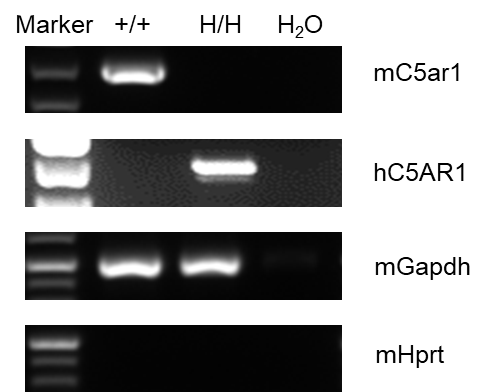
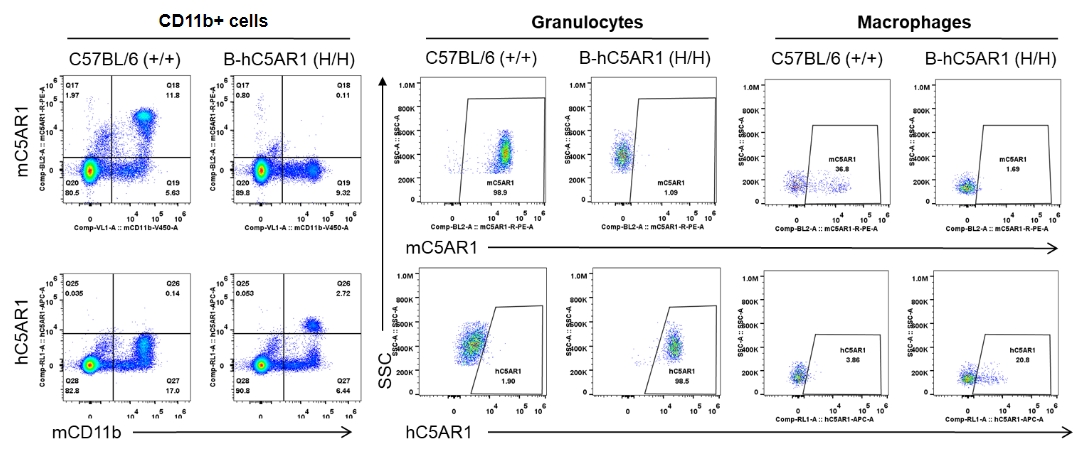
Strain specific C5AR1 expression analysis in homozygous B-hC5AR1 mice by flow cytometry. Splenocytes were collected from WT and homozygous B-hC5AR1 (H/H) mice, and analyzed by flow cytometry with species-specific anti-C5AR1 antibody. C5AR1 was detectable in mouse spleen CD11b+ cells, granulocytes and macrophages. Mouse C5AR1 was detectable in WT mice. Human C5AR1 was exclusively detectable in homozygous B-hC5AR1 but not WT mice.
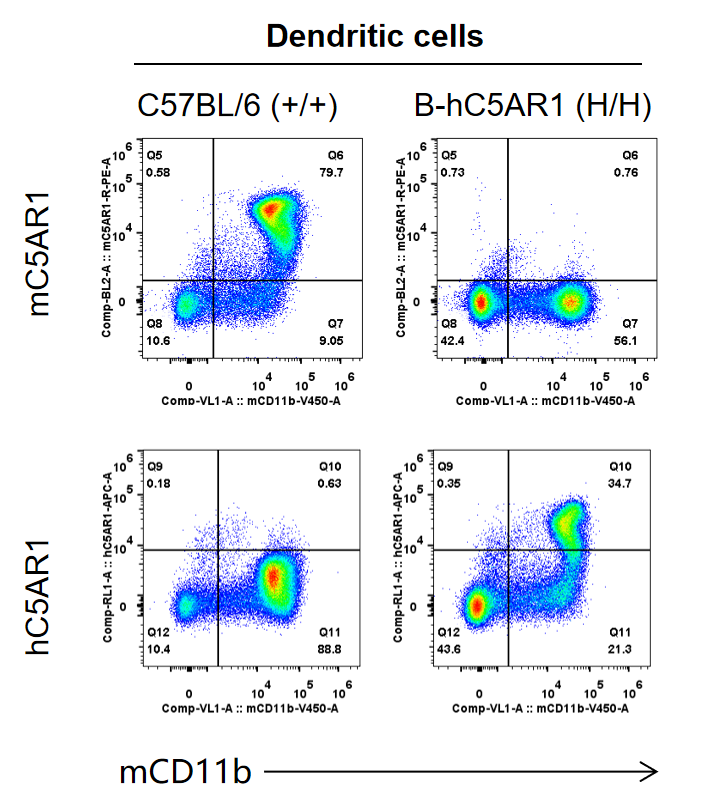
Strain specific C5AR1 expression analysis in homozygous B-hC5AR1 mice by flow cytometry. Bone marrow were collected from WT and homozygous B-hC5AR1 (H/H) mice, and analyzed by flow cytometry with species-specific anti-C5AR1 antibody. Mouse C5AR1 was detectable in WT mice. Human C5AR1 was exclusively detectable in homozygous B-hC5AR1 dendritic cells but not WT mice.
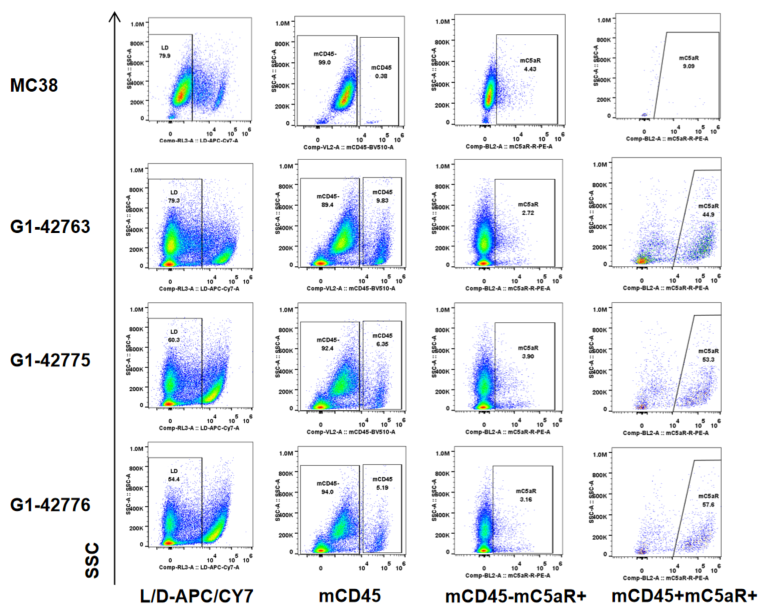
Strain specific C5AR1 expression analysis in MC38 cell line and MC38 intratumor by flow cytometry. MC38 cells were subcutaneously inoculated into C57BL/6 mice, and tumors were removed and prepare tumor cells when tumor volume reached appropriate size. MC38 cells and MC38 intratumor cells were collected and analyzed by flow cytometry with species-specific anti-C5AR1 antibody. Mouse C5AR1 was detectable in intratumor CD45+ cells but not in MC38 cells and intratumor CD45- cells.

Strain specific C5a expression analysis in MC38 cell culture supernatant and MC38 tumor tissue grinding solution by flow ELISA. MC38 cells were subcutaneously inoculated into C57BL/6 mice, tumors were removed and prepare when tumor volume reached appropriate size. MC38 cell culture supernatant and MC38 tumor tissue grinding solution were collected and analyzed by ELISA with mice complement C5a ELISA kit. Mouse C5A was detectable in tumor tissus suspension but not in MC38 cell culture supernatant.
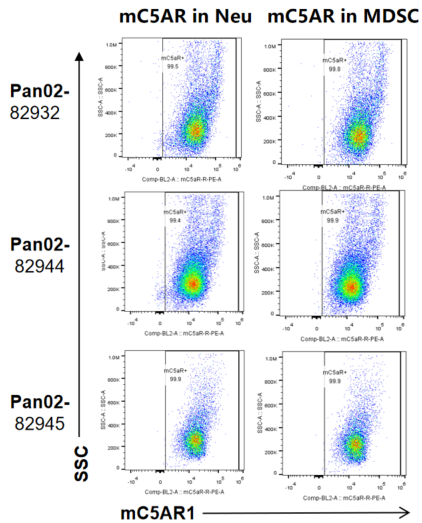
Strain specific C5AR1 expression analysis in Pan02 intratumor by flow cytometry. Pan02 cells were subcutaneously inoculated into C57BL/6 mice, and tumors were removed and prepare tumor cells when tumor volume reached appropriate size. Pan02 intratumor cells were collected and analyzed by flow cytometry with species-specific anti-C5AR1 antibody. Mouse C5AR1 was detectable in intratumor mCD11b+mGr-1+ cells and mCD11b+mGr-1+mLy-6G+ cells.
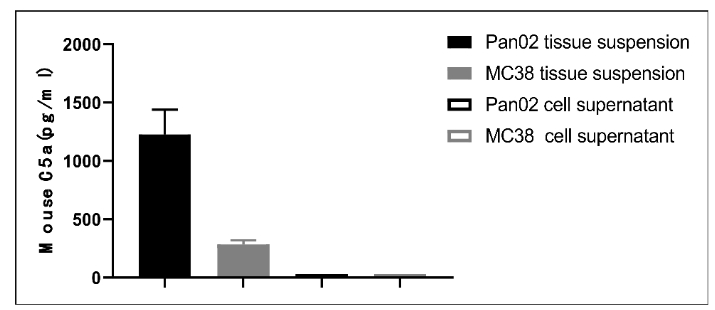
Strain specific C5a expression analysis in Pan02 cells, MC38 cells culture supernatant and Pan02, MC38 tumor tissue grinding solution by ELISA. Pan02 and MC38 cells were subcutaneously inoculated into C57BL/6 mice, tumors were removed and prepare when tumor volume reached appropriate size. Pan02 cells, MC38 cells culture supernatant and Pan02, MC38 tumor tissue grinding solution were collected and analyzed by ELISA with mice complement C5a ELISA kit. Mouse C5a was detectable in tumor tissues suspension but not in cell culture supernatant.

Analysis of leukocytes subpopulation in spleen Splenocytes were isolated from C57BL/6 and B-hC5AR1 mice (n=3). The proportion of leukocytes subpopulation was tested by flow cytometry. As a result, the expression profile of leukocytes subpopulation in homozygous and B-hC5AR1 mice is similar to that in the C57BL/6 mice, indicating that differentiation of T, B, NK, Monocyte, DC and macrophage cells are not affected by the humanization of B-hC5AR1 mice.
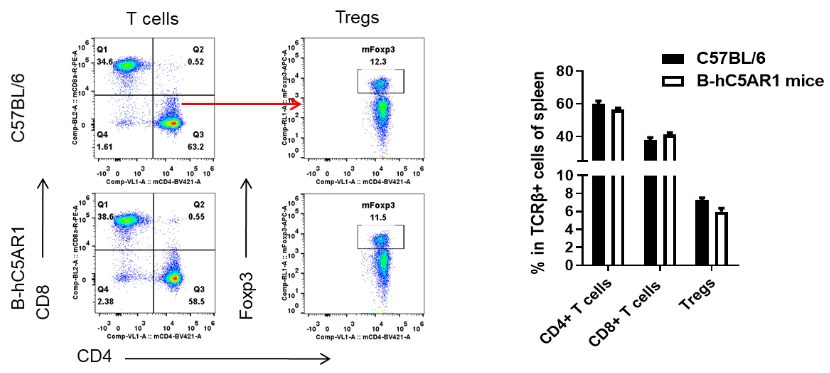
Analysis of T cell subpopulation in spleen The lymphocytes were isolated from spleen in C57BL/6 and B-hC5AR1 mice (n=3). The proportion of T cells subpopulation was tested by flow cytometry.

Analysis of leukocytes subpopulation in lymph node The lymphocytes were isolated from C57BL/6 and B-hC5AR1 mice (n=3). The proportion of leukocytes subpopulation was tested by flow cytometry. As a result, the expression profile of leukocytes subpopulation in homozygous and B-hC5AR1 mice is similar to that in the C57BL/6 mice, indicating that differentiation of T, B, NK, Monocyte, DC and macrophage cells are not affected by the humanization of B-hC5AR1 mice.
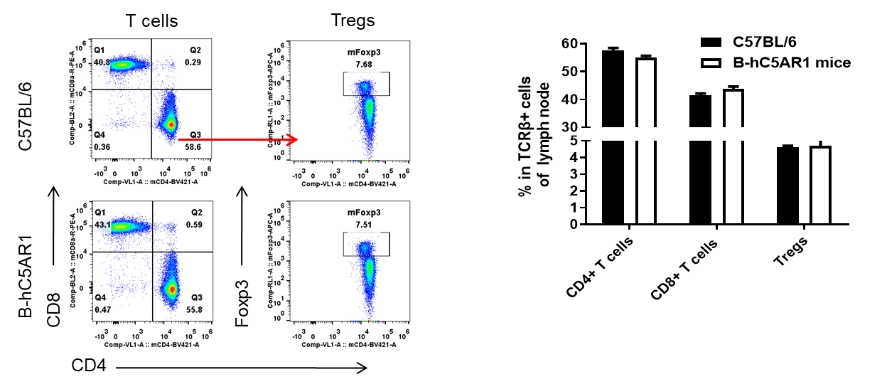
Analysis of T cell subpopulation in lymph node The lymphocytes were isolated from lymph node in C57BL/6 and B-hC5AR1 mice (n=3). The proportion of T cells subpopulation was tested by flow cytometry.

Analysis of leukocytes subpopulation in blood Blood were isolated from C57BL/6 (n=3) and B-hC5AR1 mice (n=3). The proportion of leukocytes subpopulation was tested by flow cytometry. As a result, the expression profile of leukocytes subpopulation in homozygous B-hC5AR1 mice is similar to that in the C57BL/6 mice, indicating that differentiation of T, B, NK, Monocyte, DC and macrophage cells are not affected by the humanization of B-hC5AR1 mice .
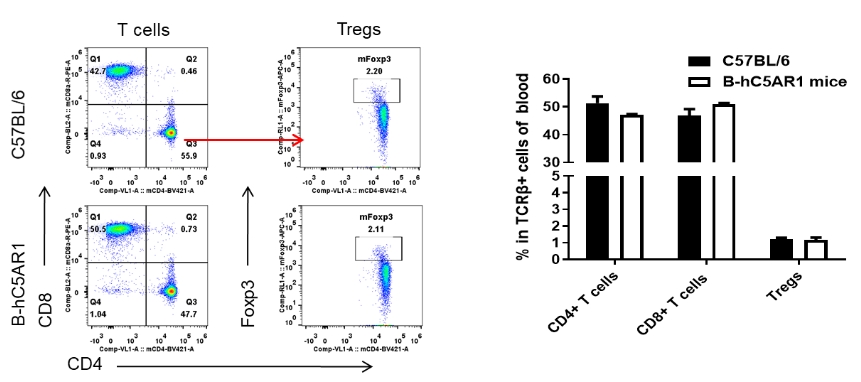
Analysis of T cell subpopulation in blood The lymphocytes were isolated from blood in C57BL/6 (n=3) and B-hC5AR1 mice (n=3). The proportion of T cells subpopulation was tested by flow cytometry.
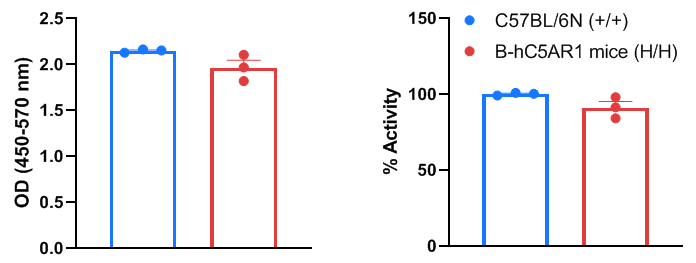
Hemolytic activity analysis of classical pathway. Serum was collected from wild-type C57BL/6N mice (+/+) and homozygous B-hC5AR1 mice (H/H) (male, 6 weeks old, n=3). The hemolytic activity was analyzed by the detection of mouse C9 complement in MAC with the ELISA kit (Hycult Biotech, HIT420). Results showed that the hemolytic activity of classical pathway in B-hC5AR1 mice was similar to that in wild-type C57BL/6N mice. Values are expressed as mean ± SEM.